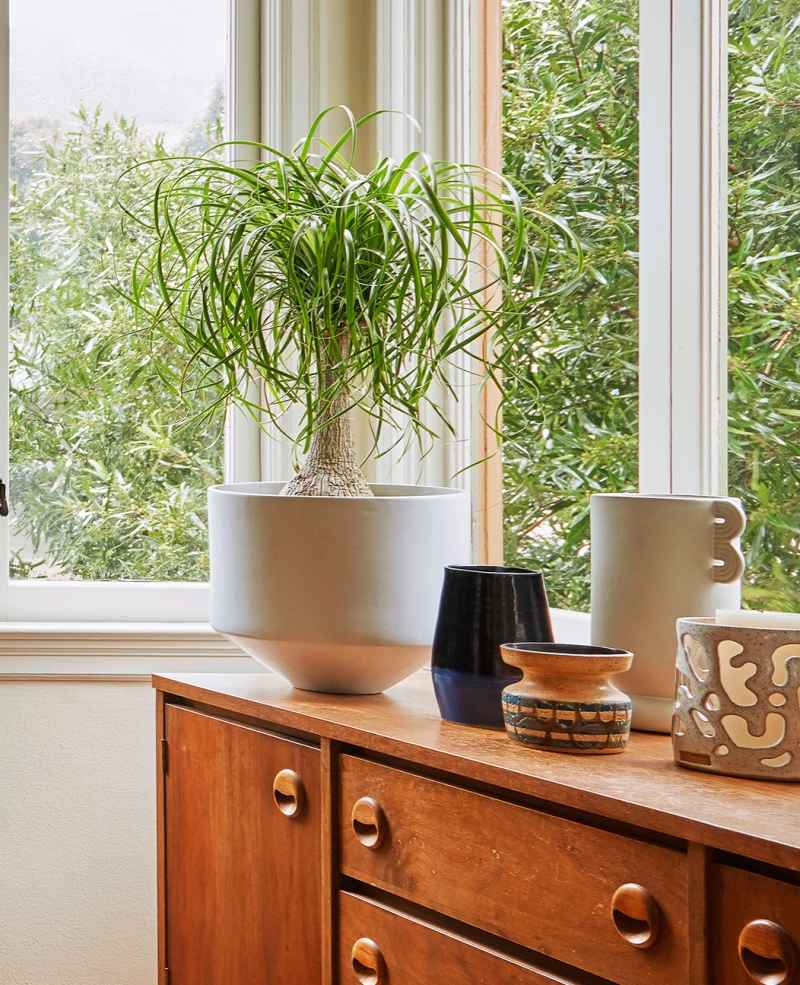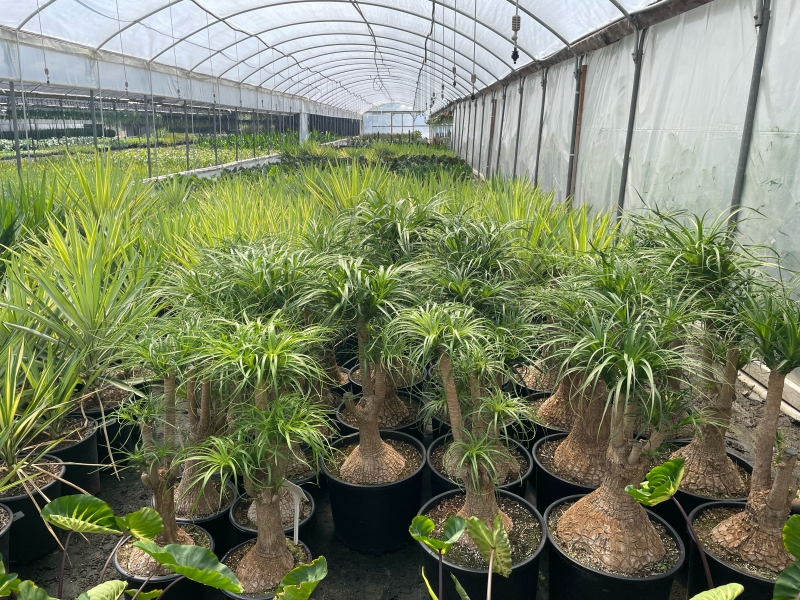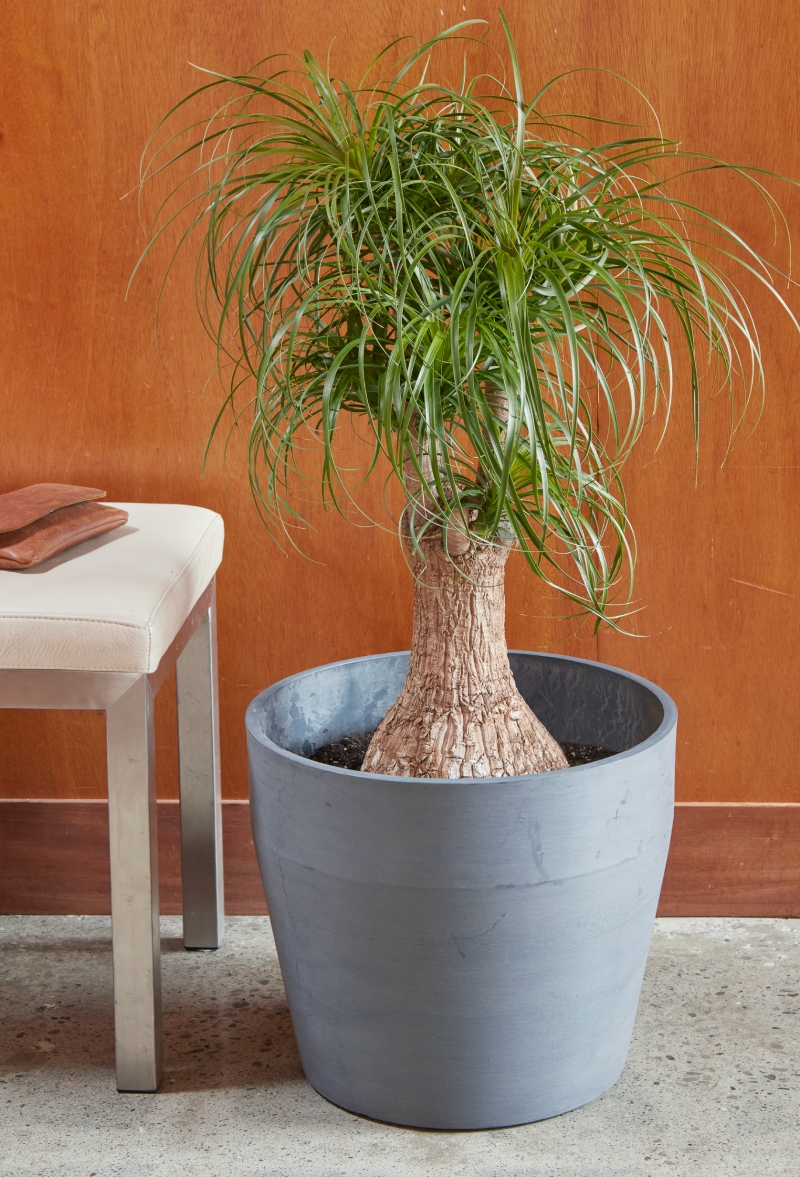Beaucarnea recurvata
ponytail palm
So much character in this palm like plant! Its bulbous caudex holds a thin trunk that is often single, but can also be branched. Whimsical grassy tufts top each trunk.



 |
height |
2–6ft |
 |
width |
1–3ft |
 |
tolerates |
Drought, Heat, Pots, Neglect |
 |
water
needs |
Low |
 |
water
info |
This plant has adapted a large caudex (swollen trunk) to store water and as such is very drought tolerant. It will want water around every two to five weeks. Let the soil totally dry out, but do not let it go bone dry and then sit around for a month or so; once the soil is totally dried out water your plant! Remember that the top of the soil may feel dry, while residual water remains deeper in the pot. Since water is heavy, a light potted plant often indicates it is time to water, especially with smaller pots. You can also lift the planter and peak in the holes at the bottom to see if you see moisture. This plant will tolerate more water during it’s summer growth period, and less during its winter rest. |
 |
hardy
to |
28F |
 |
exposure |
Full Shade – Full Sun |
 |
indoor
outdoor |
Outdoor |
 |
drainage |
In Ground: Cactus Mix, In Pots: Cactus Mix, Tolerates Sandy Soil |
 |
fertilizing |
All Purpose |
 |
origin |
E Mexico |
 |
california
native |
No |
 |
sunset
zones |
13, 16–24, H2 |
OUTDOOR EXPOSURE GUIDE

Full Sun
Six or more hours of sun beams directly landing on the plant's leaves.
Part Shade
Three to five hours of sun beams directly landing on the plant's leaves.
Part Sun
One to two hours of sun beams directly landing on the plants leaves.
Full Shade
The plant is never fully lit by sun beams,
but is in a bright spot or has dappled sunbeams playing over the leaves throughout the day.
Deep Shade
The plant never has dappled light on the leaves, and is in a place that feels dim, even on a nice sunny day.
SUNSET ZONES MAP

Growing Notes
When old lower leaves get brown and crispy they can be tugged off to expose a smooth trunk.
If the trunks of this plant are cut back hard it’s about 50:50 whether or not they will regrow or not. When they do it’s with many new heads. This is a way that growers get those fat, low, bushy specimens. Since attrition rates are fairly high, so this is not recommended at home.
If planted on a tilt the trunk will grow upright, creating a bend in it.
Not poisonous to cats and dogs, though cats do love it as a scratching post!
This plant occasionally attracts mealy bugs, so keep an eye at the base of the leaves in the crown. If these furry white clusters are seen treat them as soon as possible with a horticultural oil, soap, or rubbing alcohol.
Special Interest
The ponytail palm is not an actual palm; the common name comes from its similar form of growth.
Each plant is male or female, with males having a reddish pink flower and females having a creamy white flower. Flowers are exceedingly rare indoors, but do occasion pop off when a heat spell comes through.
We have heard this is one of the trees growing where Dr. Seuss grew up, surely inspiring his whimsical plant characters.
Beucarnea species hybridize readily and most we see grown as houseplants have some Beaucarnea guatemalensis in them. This is evidenced on plants that have softer thinner leaves, a thinner trunk with less pronounced caudex or leaves that have more movement in them. Others with very stiff leaves likely have some Beaucarnea stricta in their family tree.
More Info
This plant has been raised to live indoors; however, it can also grow outdoors in mild areas of California. Keep in mind that the plant will go through a stressful transition, especially if moved outside in particularly hot, cold, or wet weather. Even if this plant will eventually thrive in direct sunlight, it has not been grown in this level of light, so if you plant it in direct sun, just expect that the leaves may burn at first, then happily regrow as they acclimate to the new levels of light. Planting in the spring or fall will help with this transition.
Very slow if grown in the fog belt.




